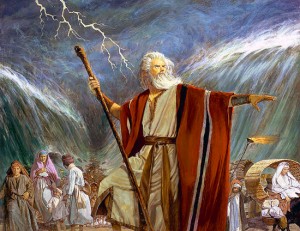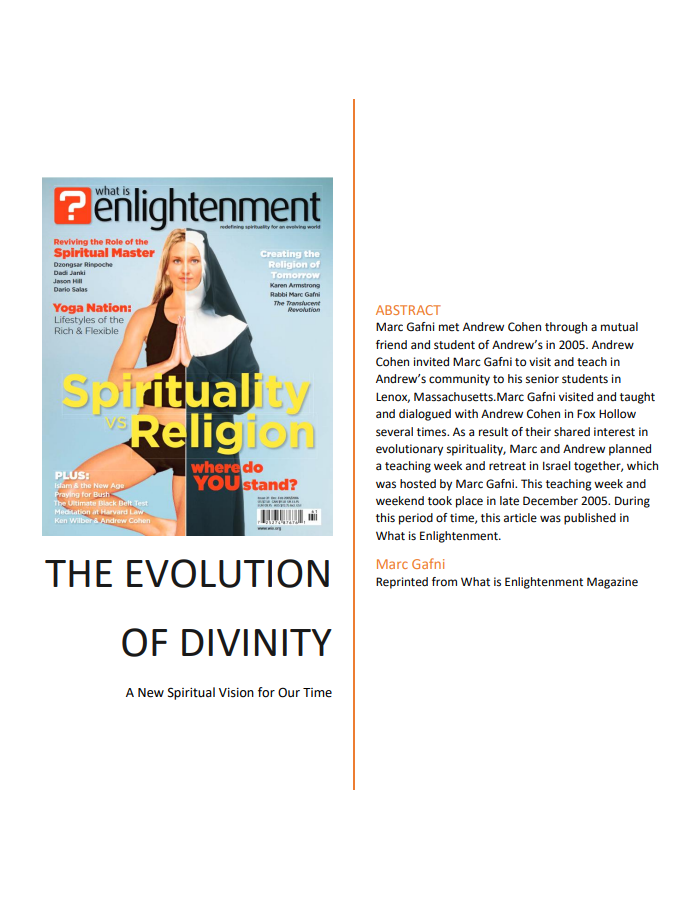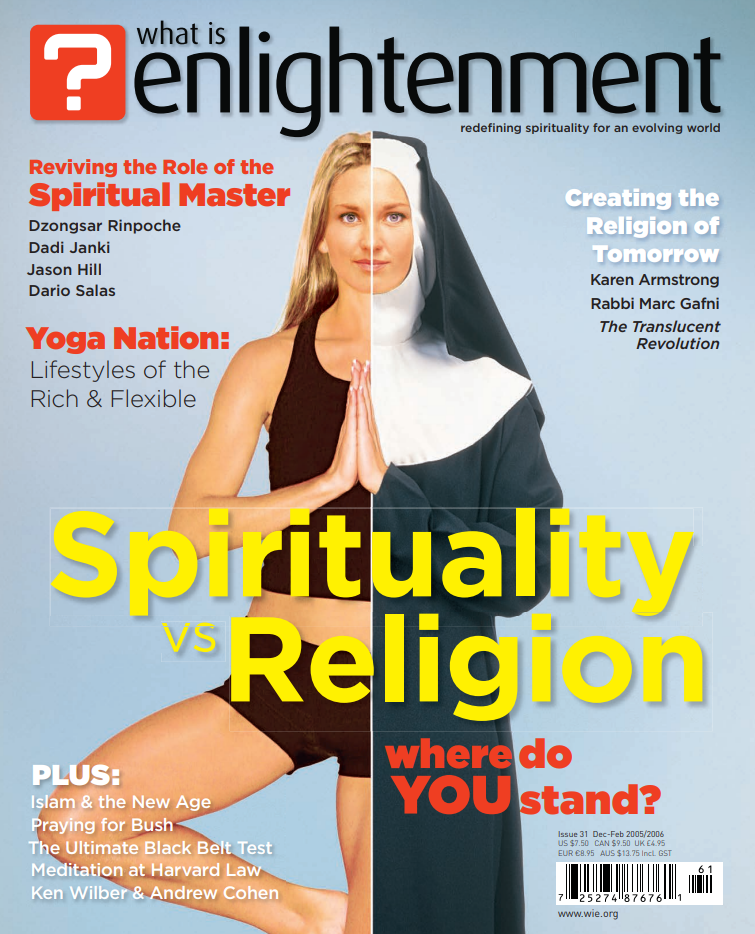Dr. Marc Gafni: Calling in an Integral Religion
An Excerpt from Dr. Marc Gafni’s Book Tears
Society, as it is currently constructed, is designed to bypass your tears. Yet, crying is an art. Tears are the colors with which the tapestry of your awakening is painted. Sometimes we cry surface tears in response to stuff that happens – good stuff and bad stuff. But the truest tears are those that well up from the deepest place on the inside of the inside – they may be triggered by a specific event or image, but they are larger than any one event.
Every time you cry these true tears, you cry for all the times you never cried before. True tears come only on occasion, but when they do, they are harbingers of great wisdom and guidance. These are the tears of the holy of holies. They carry revelation. To receive that revelation, you must be willing to sit still and be truly alone, so that your deep core can come out naked. From that place you wail, flooded to the core by deep sadness or profound happiness. These are not superficial tears but what we might call source tears. To hear the voice of source tears emerge, we must access the ground of dynamic stillness which is the well from which this revelatory crying rises up.
Love and Teaching, NonDual Humanism and the Democratization of Enlightenment (A Book Excerpt from Radical Kabbalah by Dr. Marc Gafni)
Introduction to the book Radical Kabbalah by Dr. Marc Gafni
Mordechai Lainer of Izbica is my chosen lineage master. My prayer is that I have honored him with a correct and proper understanding of his trans-mission and teaching. I believe that I have. Though this personal introduc-tion is not meant to fully outline his teachings, a few remarks may orient the general reader and guide the initiate.
An Esoteric Transmission
First of all, this book is both an academic study and a transmission of an esoteric doctrine. Part of the disguise of this work is its presentation as a piece of academic scholarship.
Of course, on one level it is precisely that, for which I have to thank Professor Moshe Idel. At some point in 2001 or so, Professor Idel told me off-handedly that I needed to do an academic doctorate at a good univer-sity in order to insure that my non-academic writing and teaching be taken seriously. He very kindly accepted my request that he act as my co-advisor at Oxford University. I am in his debt for his gracious, insightful and often penetratingly brilliant remarks, which guided the unfolding of this work in an academic context.
Having said that, the academic framework is just that, a framework—and something of a fig leaf—for the deeper teaching of Lainer, which I have humbly and perhaps audaciously tried to unfold in this volume.
When I was thirty-one, living in Israel near Tel Aviv, Prof. Moshe Halamish suggested that I study and write about this great master. I had barely heard of Mordechai Joseph Lainer, and was wholly unfamiliar with his writings collected in two volumes under the title Mei Hashiloah (MH). Halamish’s prompt was the beginning of my relationship with Lainer, which deepened and shifted again many times over the years. At the time, thanks to Rabbi Shlomo Carlebach, who was deeply connected to Lainer’s teaching, the Torah of Izbica was just beginning to gain currency in cer-tain neo-Hasidic circles in Israel and the United States. At some point,
I realized that I felt a soul root connection with his teaching, and began to teach his Torah to my own circles of students.
This period of teaching Mei Hashiloah lasted about ten years. Some five years into this teaching period, I spent one year of 16 hour days in the li-brary at Oxford in an intense, in-depth encounter with Mordechai Lainer.
In approaching the master and his text during that year, I followed the three-stage path of textual reading taught by the Baal Shem Tov. First, in a state of what the Baal Shem calls hahna‘ah, reverential submission to what one is learning, I read every passage again and again, praying that I might realize Lainer’s deeper intention and receive his transmission. Second, I moved from submission to what the Baal Shem calls havdalah, separation. In this stage of havdalah, I deployed a method of analysis which involved two basic steps. As I read, I made a list of key topics, words and texts in Lainer. I subsequently gathered every reference to that text, theme or image, searching for the underlying pattern. At the same time I learned, together with my friend Avraham Leader, many of the original Zoharic sources that would have influenced Mei Hashiloah, to get a sense of how he was reading the tradition, what he changed in his interpretation, and why.
Eventually, stage two yielded to stage three, which the Baal Shem Tov calls hamtakah, sweetening. Hamtakah involves an erotic ‘nondual’ merger with the text, which occurs when the reader and that which is read become one. It is at this stage that the deeper intention of the Lainer’s Torah became startlingly lucid, delightful, and beautiful, and the entire teaching opened up with radical clarity and joy.
As I continued my teaching in the world, I sought, as every authentic student does, to both teach and evolve this Torah. One expression of this process was the book Soul Prints (Simon and Schuster 2001) and the Soul Prints Workshop, (Sounds True 2004) which I published dur-ing the years 2001–2003. Another is the book you have before you. This academic work of mystical hermeneutics is complimented by the Journal of Integral Theory and Practice 6:1 (Suny Press 2011) and Your Unique Self: The Radical Path to Personal Enlightenment, (Integral Publishing 2012).
The Evolution of Divinity – From What Is Enlightenment Magazine – by Dr. Marc Gafni
A New Spiritual Vision for Our Time
Reprinted from What Is Enlightenment Magazine
Abstract:
Marc Gafni met Andrew Cohen through a mutual friend and student of Andrew’s in 2005. Andrew Cohen invited Marc Gafni to visit and teach in Andrew’s community to his senior students in Lenox, Massachusetts. Marc Gafni visited and taught and dialogued with Andrew Cohen in Fox Hollow several times. As a result of their shared interest in evolutionary spirituality, Marc and Andrew planned a teaching week and retreat in Israel together, which was hosted by Marc Gafni. This teaching week and weekend took place in late December 2005. During this period of time, this article was published in What Is Enlightenment.
Shalom Mountain Wisdom School: A Report by Dr. Zachary Stein
The page you are trying to reach is part of our Great Library Stacks & Archives. If you already signed up for our FREE Great Library card, please log in to access this content.
If you are not yet a Library Card owner, you can sign up to get access.
A Gift from the CIW Board Retreat 2017: Introduction by Dr. Marc Gafni: Never Bypass the Personal
Enjoy this beautiful introduction and story by Dr. Marc Gafni from our 2017 CIW Board Retreat:
The Story of Levi Isaac of Berdichev Told by Dr. Marc Gafni
from the book Your Unique Self by Dr. Marc Gafni
When you fail to hold the personal, you may begin to engage in manipulation or possibly even psychological abuse. When you begin to see yourself as aligned with the process, which was the great teaching of Hegel, you may inadvertently give birth to the worst evils of Fascism, Communism, and Nazism, all of which were very heavily influenced by Hegel’s teaching that demanded that the individual must awaken and identify with the great evolutionary process of divine unfolding in absolute spirit. In Hegel’s powerful clarion call to align with the ecstatic impulse of historically unfolding evolutionary God, the holiness of the individual was somehow crushed in all the grand rhetoric, with devastating results for God and humans. The process must always remain personal.
For me it was always the Hasidic master Levi Isaac of Berdichev who radically reminded me of the primacy of the personal even when in the throes of evolutionary ecstasy. Levi Isaac was once leading the prayers at the close of Yom Kippur services. Yom Kippur is a fast day and the holiest day in the Hebrew calendar. The twilight hours at the end of the fast are filled with potency. According to the evolutionary mystics of Kabbalah, the enlightened prayer leader, during that time may potentially enter the virtual source code of reality and effect a tikkun; that is, effect a momentous leap in the evolution of consciousness for the sake of all sentient beings, in all generations. This is precisely what Levi Isaac—greatest of all enlightened evolutionary prayer leaders—was doing on that Yom Kippur. Night had already fallen, the fast was officially over, but the ecstasy of Levi Isaac was rippling through all the upper worlds. All beings held their breath in awe of the evolutionary power of Levi Isaac’s consciousness. All of reality was pulsating with him towards an ecstatic evolutionary crescendo. Just as the great breakthrough was about to happen at the leading edge, Levi Isaac spotted out of the corner of his eye an old man who was thirsty. The fast had been very long and the old man needed to drink. So in the midst of his ecstasy, Levi Isaac brought the whole evolutionary process to a halt. He immediately ended the fast and personally brought the old man a drink of water.
You Are God’s Unique Intimacy – Marc Gafni’s Passover Sermon at Pacific Coast Church
The page you are trying to reach is part of our Great Library Stacks & Archives. If you already signed up for our FREE Great Library card, please log in to access this content.
If you are not yet a Library Card owner, you can sign up to get access.
Enlightenment of Fullness — Yetzir and Yetzirah, Part III
The page you are trying to reach is part of our Great Library Stacks & Archives. If you already signed up for our FREE Great Library card, please log in to access this content.
If you are not yet a Library Card owner, you can sign up to get access.
Wisdom for Your Week: Divine Tears
The page you are trying to reach is part of our Great Library Stacks & Archives. If you already signed up for our FREE Great Library card, please log in to access this content.
If you are not yet a Library Card owner, you can sign up to get access.
Enlightenment of Fullness — Yetzir and Yetzirah, Part I
Looking for more on the wisdom tradition that aligns you with your deepest creativity? In a three-part excerpt from the long version of Soul Prints, Marc Gafni writes that we can transform and raise our passion and artistic creativity into a powerful drive for the sensual and the holy, realizing that, in a redeemed world, they are one and the same. As long as our spirituality remains vapid and empty, we indeed need to repress the more primal, creative passion, lest it overwhelm us. Primal passion unrealized is soul print or Unique Self destiny unrealized.
You can view Part II of this essay in full by clicking here>>
You can view Part III of this essay in full by clicking here>>
Yetzer and Yetzirah: Raising the Primal Sparks of Creativity and Passion
by Dr. Marc Gafni
from “The Way of the Dragon“ in the long Soul Prints.
Part I.
In biblical spirituality, information about God is relevant for one reason only. Information about God is information about us. We are commanded to be little Gods – to imitate God. Just as God stood at the abyss of darkness and said let there be light, so are we commanded to stand at the abyss of our darkness and say let there be light. A little bit of light dispels so much of the darkness. Further, just as God is a creator – creating, sculpting, painting, composing a gorgeous physical world – so, too, are we invited to create, to sculpt, to paint, and to make music.
Mozart, Bach, Schubert, Rembrandt, and Michelangelo created. And yet, creativity is still viewed as suspect by much of the religious community. Art per se and artists to be sure are suspected of being amoral at best and, more probably, immoral. Acting, painting, sculpture, song are held in both high esteem and moral disdain. Why? The answer, which we have already introduced in our earlier discussion, emerges from an understanding of the deep linguistic and conceptual relationship between the biblical myth terms Yetzer and Yetzirah. Yetzirah means creativity; Yetzer is best translated as primal instincts, including but not limited to libido (Freud), the drive for power (Adler, Nietzsche), and the need for meaning (Frankel). In the Hebrew language, which is the ultimate source of all biblical myth thought, Yetzer and Yetzirah are the same word, linked etymologically and conceptually. The point: I cannot create without connecting deeply to my most primal instincts.
In my earlier twenties, I attended for a short time a prestigious drama workshop in Greenwich Village in New York. When we would be preparing for a murder scene in a play, we would do exercises to help us access the murderous rage lurking untapped in the corners of our souls. I cannot create drama about murder without unlocking the murderer in myself. To create anything – and certainly for the ultimate creation, the creation of myself – I need to be able to access the most primal passions of my being. Herein lies the attraction and the danger. My primal instincts when not integrated into my fully developed self are often not channeled properly and can potentially destroy worlds. Witness Germany. My mother, who was there, told me almost every day as I was growing up that the same people who gassed Jews in the morning, listened, with great primal passion, to Mozart in the evening.
In response to this psychological reality, Biblical myth spirituality taught: “Who is heroic, he who is (Kovesh) conquers his Yetzer.” And if the price is also to sacrifice certain forms of creativity, so be it. Better to be moral, holy, and not creative, than creative and immoral.
And yet having to choose between the primal passion of creativity and morality is far from satisfying!!
Visit centerforintegralwisdom.org for more wisdom teachings from Dr. Marc’s writings and the other teachers of the Center for World Spirituality.
Marc Gafni and Charles Randall Paul: The Roots of Individuality
The page you are trying to reach is part of our Great Library Stacks & Archives. If you already signed up for our FREE Great Library card, please log in to access this content.
If you are not yet a Library Card owner, you can sign up to get access.
Foundations for World Spirituality: Learning the Language of God (Part 4 of 5)
Editor’s note: The following essay by Marc Gafni is published as a white paper of the Center for Integral Wisdom think tank. Our Spirit’s Next Move blog is pleased to announce the paper’s availability.
Ten Words to Live By
The second biblical myth word symbol of freedom is actually mistranslated into English as the Ten Commandments. The people, so the story goes, having fled Egypt, gather at the foot of Mount Sinai to receive the Ten Commandments. Of course, nowhere in the biblical myth is there any mention of Ten Commandments. Here is where the old witty maxim, “Reading the bible in translation is like kissing a woman through a veil,” becomes not altogether untrue. In the original Hebrew, the people receive at Sinai not Ten Commandments but “Ten Words.” Here Voice becomes Word, the articulation of speech. It is the beginning of the vision that follows revolution.
The third word symbol is no less than the word “Messiah.” “Messiah” in the original Hebrew is understood by the Kabbalists, quite astoundingly, to mean “conversation.” Master Nachum of Chernobyl, mystic and philosopher, points out that the Hebrew word for messiah, Mashiach, can be understood as the Hebrew word Ma-siach – meaning “from dialogue” or “of conversation.” His assertion radically implies that the Messiah is potentially present in every human conversation””every mutual act of voice-giving.
All authentic conversation is sacred conversation. The ability to have an honest face-to-face talk in which both sides are true to themselves, vulnerable and powerful at the same time, is Messianic.
Simply put, sacred conversation is the vessel that receives the light of Messiah.
Sounds of Silence
The soul print of the emancipated storyteller is not entirely realized with the move from mute silence to sacred speech. It goes one rung higher, for soul print journeys are not only linear but circular, taking us spiraling upward and beyond. The path takes us from silence to speech and then back–to a higher silence that will birth a higher speech.
We return to the most famous biblical myth image of speech–the “Ten Words” spoken at Sinai. The Kabbalists, as you by now expect, have a different interpretation. In fact, according to the Kabbalists, God had nothing special to say that particular morning. God said what God says every day! “I am here,” he said. “I am present. The world is meaningful. Every human being is created in my image and therefore has infinite value and dignity.” In the language of the Kabbalists, “A voice issues forth daily from Sinai saying, ”˜I am the Lord your God.’” This is not a statement of theology but an affirmation of meaning and relationship based on voices in sacred conversation.
On that auspicious day at Sinai, we heard a voice not so much because God spoke, but because we listened. We got quiet. So did the whole world. In the wonderful imagery of the third century myth masters, “On the day of revelation a bird did not chirp, an angel did not sing, an ox did not bellow, the sea did not rage – the entire world fell silent”¦and the voice at Sinai was heard.”
The voice can be heard only from the silence.
This post is part of a series of posts “Foundations for World Spirituality: Learning the Language of God” which begins with Part 1. For Part 2, Part 3, and Part 5, follow the links.
Foundations for World Spirituality: Learning the Language of God (Part 3 of 5)
 By Marc Gafni
By Marc Gafni
Editor’s note: The following essay is published as a white paper of the Center for World Spirituality think tank. Our Spirit’s Next Move blog is pleased to announce the paper’s availability.
The Second Stage: from Silence to Sound
The beginning of freedom is the emergence of voice. This stage is expressed both by the initial cry of the Israelite slaves that broke their silence, as well as by Moses’ arrival on the scene. “When Moses came, voice came,” writes the Zohar. Moses does what the charismatic revolutionary always does: he gives voice to the people. Indeed, biblical myth text records the beginning of redemption with the following words: “”It came to pass in the course of many days that the King of Egypt died and the children of Israel sighed by reason of the bondage and they cried out and their cry came up unto God.” The enslaved Israelites are received by the presence of God at the point when they move from the dumb silence of the slave to sound which is the beginning of speech, the characteristic of a free people. This “cry” is not an elegantly articulated protest – it is a cry as in the cry of a wolf, or the cry of an infant. It is primal, impassioned, pre-civilized, a howl of protest that makes it into the halls of heaven, heard by God himself.
For the first time the enslaved can express distress. They seek to articulate words that are not yet ready to form themselves on their lips. At this stage of moving toward freedom, we do not yet know how to tell our story. We do not know what we would do with the world if it were given over to our stewardship. We just know that we must protest.
The biblical myth symbol (Leviticus 25) for the transition from slavery to freedom is the primal blast of a ram’s horn. No trumpet of gold, it is rather the rawness of the ram’s horn that captures the slave’s first fitful sounds. The first thing a revolutionary movement must do is sound its ram horn–start a newspaper, set up a radio station, build an internet site. It is not by accident that the fundamentalist and totalitarian states are trying to disallow or severely limit internet access. Freedom’s beginnings are expressed in the first shouts of protest.
The sixties and seventies were such second-stage revolutionary generations. This helps explain why so many sixties hippies became late seventies and early eighties yuppies and then transformed again into the establishment of the nineties. The feeling of distress generated protest – sound and even the first glimmerings of voice–but there was no alternative vision of society to generate “speech.” Similarly, many third world revolutionaries reflect such second stage thinking. Consequently, as we all know, that not a few third world revolutionaries became the leaders of far more repressive regimes than the ones they overthrew. Because they lacked speech to articulate the primal manifestations of voice, they needed to repress all of their own pain, the very distress and disease that initially led to the revolution.
What can they do when the revolution has happened and the dis-ease remains? Only two choices are available. The revolutionary can choose to look inside personal and societal soul in a very profound way, attempting to wrestle with the dis-ease at its source and not merely on a symptomatic level. This would involve addressing the ills of society that provoked revolution–through the creation of a new society with just laws and a conceptual framework to insure the continued freedom of the people. This is the move from primal voice to speech. Or the revolutionary can lash out to avoid the necessity of confronting his own emptiness. Lashing out is always easier but not a stage of growth. It continues and repeats the stage-two voice of protest. The repression it produces is often brutal and animalistic.
Like all stages of growth – stage two is necessary and positive when it is part of a process. Arrested growth, however, always produces some form of pathology.
The Third Stage: From Sound to Word
In the third stage, voice gives birth to word. Now we are able to tell our story – to speak authentically with each other, to articulate clearly both our needs and our visions of a better world. A rebel newspaper is no longer sufficient. Only in the writing of a constitution or a Declaration of Independence is the next stage of freedom achieved. Or in the case of the sixties, a spiritual movement needed to be born which attempts, however imperfectly, to write the books of a New Age.
Three biblical myth word symbols capture this third stage in mystical consciousness.
The first word symbol is called in Hebrew the haggadah””literally, “the story telling.” This is the very name of the myth text we read from at Pe-Sach, when we reclaim our story. By assuming authorship of our stories, we assert spiritual authority over our lives. We are no longer subject to will and directive of the taskmaster, priest, or rabbi. By becoming authors of our own haggadah, we progress past the protest and actually become free.
The master Kalonymous Kalman explains that the demarcating characteristic of messianic times is that every person will be his or her own spiritual master. This is his radical reading of the biblical myth vision expressed by prophet Jeremiah “And no man will anymore learn from his fellow to know God, for everyone will know Me from the wise to the simple.” Every person will find voice and articulate speech and those words will be his or her spiritual guide. In the end, we will discover that we are the sacred book and the sacred book is us. In fact, there is a tradition in Jewish prayer to take the Torah scrolls adorned with crowns of silver and fine cloth and carry them around the prayer room, allowing everyone to touch and kiss them. Where I pray, we started a tradition of also kissing the person chosen to carry the scrolls, recognizing that she too is a sacred scroll.
This post is part of a series of posts “Foundations for World Spirituality: Learning the Language of God” which begins with Part 1. For Part 2, Part 4, and Part 5, follow the links.
Dr. Marc Gafni: Foundations for World Spirituality: Learning the Language of God (Part 1 of 5)
Editor’s note: This is the first part of 5-part essay, published as a white paper of the Center for Integral Wisdom think tank. For Part 2, Part 3, Part 4, and Part 5, follow the links.
 “As the Kabbalists point out, the word Moses spelled backwards is Ha Shem, meaning ‘the name.’ Importantly, Ha-shem in biblical Hebrew also is the most common reference to God’s name. When you respond to your call and realize your soul print, fully becoming your name, you become one with God. When Moses did this, he found his voice, he became a prophet.”
“As the Kabbalists point out, the word Moses spelled backwards is Ha Shem, meaning ‘the name.’ Importantly, Ha-shem in biblical Hebrew also is the most common reference to God’s name. When you respond to your call and realize your soul print, fully becoming your name, you become one with God. When Moses did this, he found his voice, he became a prophet.”
By Marc Gafni
To live your story is to move from a state of slavery to freedom. Slavery is not limited to our old image of the oppressed Hebrew or black slave being whipped by the cruel master. We are all potentially free, just as we are all potentially slaves. Our intent in this brief essay is to at least begin to unpack a core intuition of the Zohar that a free person is a person who has found voice. As we shall see in the very last paragraphs of this discussion the implications of freedom are wondrous indeed!
The Hebrew name for the Passover Storytelling Ritual, which celebrates and reenacts the dynamic movement from slavery to freedom, is Pe-Sach. Renaissance mystic Isaac Luria reminded us that Pe-Sach is a combination of two words Peh, meaning “mouth,” and Sach, meaning “talk.” Pe- Sach, therefore, means the mouth that talks.
One school of Hasidic masters unpacks this idea by defining redemption as the emergence of speech. To move from a dumb and mute existence to a communal storytelling existence is to undergo redemptive transformation. “To be redeemed,” writes one mystic, “is to lead a history-making, storytelling, communing, free existence.” To be in exile is to lack history, tell no story, fail to commune, and exist as a slave, silent.
The most oft cited source for this idea is a stunning passage in the Zohar which describes the Egyptian slavery as the “exile of speech.” In Kabbalah, every biblical nation represents a different organ of the body; Egypt represents the throat. The mystics read the Hebrew word “Egypt” literally as meaning narrowness. The throat is, of course, the narrow, constricted passage between the wide spaces of the heart and mind. The narrow throat, Egypt, is thus the ideal symbol for the exile of speech. Speech remains caught in the throat, in the dark passage, and can’t make it to freedom’s gateway, the mouth. Redemption comes in the birth of the word. In the actual process of your retelling, you reclaim your story. But to be capable of retelling your story you need voice. Redemption then is the process of finding voice.
The Greatest Persecution
In the Nazi concentration camps, certain people were referred to as mules. They were so broken that, although not physically impaired, they could no longer speak. Among animals, mules are the hybrid of a horse and donkey, unable to reproduce themselves. These human, muted mules were so traumatized, their souls so mangled, that they too were unable to “reproduce themselves”–to express themselves in speech.
The great master Kalonymous Kalman of Piacezna wrote from the flames of the Warsaw ghetto that the torture of the exile is not only in the physical suffering but in the inability to cry out – the loss of voice. “The people have become mute,” he cried out in a teaching given in 1940, just weeks after his son and daughter in law and many of his disciples were brutally killed. The teaching was on the story of Joseph and his brothers in the book of Genesis. In a dream, Joseph sees “the binding of sheaves in the midst of the field. And behold my [Joseph’s] sheave, rose up.” In the simple reading of the text, this is a dream of Joseph’s future power. The bound sheaves represent the servility of his brothers while the rising of his sheave is an expression of his potency. Joseph is predicting he will be lord over his brothers. Kalonimus Kalman uses the classical interpretive method of the mystic–reading the text independent of its context (here, Joseph and his brothers) and focusing on subtle wordplays and dual meanings–to extract a deeper spiritual meaning. For Kalman, the sheaves represent his disciples. The word for sheave in Hebrew also means “mute”: “My disciples are mute in the field of the spirit.” They have lost voice. Their suffering is so intense that it defies and destroys all expression. “However,” continues the master, “my sheave–that is, my muteness–must rise.” By this he means, “I must find voice.”
Kalman sees the role of the mystic leader, himself, as retaining voice, holding on at all costs to the ability to talk. He does not mean speech in the technical sense, of which even the slave is usually capable. He refers rather to the ability to have the voice that allows you to remain the storyteller of your own tale””even in the face of Nazi horror.
Kalonymous Kalman took on this role by continuing to teach even when he couldn’t be certain anyone survived to hear him. He risked all to record his teachings and hide them in the hope they would be found by some future generation. He was continuing to tell the story. In an act of heroic protest, he refused to allow the Nazis to claim “his-story.”
Kalman’s book, along with his voice, was lost in the war. He died in the Treblinka concentration camp and his book disappeared. Although he left word that he had buried his writings before being deported, they were not to be found. That is, until almost fifteen years after the Nazi defeat when a Polish worker miraculously discovered them in a pile of rubble and somehow understood their importance. The work has since been published. Treblinka may have succeeded in killing the Master of Piacezna, but it could not kill his voice. He died but his words did not. His voice triumphed.
Voices can indeed triumph even when the storyteller dies. For a version of Kalman’s story that is completely different yet exactly the same, we turn to Alice Walker’s classic work, The Color Purple. The novel focuses on two sisters, abandoned by their father to the custody of a man referred to as Mistah. One sister gets away. The other remains behind. What keeps the captive sister from losing her soul? The letters she sends to her sister. By telling her story she avoids be sucked into the slavery’s dark and deadly vortex.
In Blaise Pascal’s words, silence is “the greatest persecution.” Silence can forge the bonds of slavery even if you have not been sold by Dad to a man named Mistah or suffered the brutality of Nazism. Whenever you give up the belief that you are special and deserve to have a voice, you become a slave. Whenever you work in a place that instills fear, whenever you are afraid to speak up and ask for what is your due, you are a slave.
This post is the first in a five-part series of posts, “Foundations for World Spirituality: Learning the Language of God.” For Part 2, Part 3, Part 4, and Part 5, follow the links.
Tears and Transformation: Toward the Redemption of a Crying God
Excerpted from Chapters 1, 10, and 11 of Reclaiming Rosh Hashanah: The Dance of Tears (forthcoming, Integral Publishers)
Photo: Pink Sherbet Photography
Summary: In this essay, excerpted from Marc Gafni’s forthcoming publication Reclaiming Rosh Hashanah: The Dance of Tears, we encounter biblical myth character Rachel and her three levels of tears of transformation: human empathy for the suffering of other human beings, human empathy for the pain of God, and empathy of God for man. These three strands of Rachel’s tears form “a sacred circle of nondual love,” according to Marc in this passage. Furthermore, these tears of redemption express a core idea in Hebrew wisdom: “The human being, by engaging the Rachel archetype and entering into the pain of the Shechina in exile, can “through his tears” realize his ontic identity with the Shechina herself, and in this very realization, be aroused to great compassion and achieve redemption.” This excerpt introduces the mystical techniques of the crying of transformation and the transformation of crying. It is by accessing these tears that we offer redemption for a crying God.
In order to fully appreciate the nature of Rosh Hashanah theatre and the dance of tears, it is necessary to point out the implicit distinction between this biblical form of holy day theatre and the concept of theatre inherited by western civilization from ancient Greece. In classical Greek theatre, the operative principle was Aristotle’s understanding of catharsis. Catharsis for Aristotle meant the purging of the emotions.
Dr. Marc Gafni: Interiors, Face, and the Reconstruction of Eros
By Dr. Marc Gafni
Summary: The four faces of eros, described by Marc Gafni in this excerpt from Mystery of Love (2003), are 1.) being on the inside, 2.) fullness of presence, 3.) desire, and 4.) interconnectivity of being. As Marc describes, with its mystical role in these four expressions, the face itself is the truest reflection of the erotic. In the flow of eros, we access the experience of being on the inside of God’s face, which Marc explores here through the Temple mystery of the sexually entwined cherubs atop the Ark who are positioned face to face; the Hebrew word “panim,” which means “inside, face, and before;” and the erotic experience of having a true face-to-face conversation. This significant passage from Mystery of Love invites you to embody the erotic which is modeled but not exhausted by the sexual more deeply in your own life.
Eros has many expressions. Each expression is hinted at in the temple mysteries. There are four faces of eros which, when taken together, form the essence of the Shechina experience. In this essay, we will explore the erotic understanding which forms the matrix of the secret of the cherubs and informs every arena of our existence. As we shall see, at the very heart of Hebrew tantra was a very precise and provocative understanding of the relationship between love, sex, and eros. This will open us up to a whole new understanding of our sexuality and will show us the way to erotically reweave the very fabric of our lives in more vivid patterns, sensual textures, and brilliant hues.
The First Face of Eros: On the Inside
“What lies behind us and what lies before us are tiny matters compared to what lies within us.” – Ralph Waldo Emerson
The cherubs in the magical mystery of Temple myth were not stationary fixtures. No, these statues were expressive, emotive. They moved. When integrity and goodness ruled the land, the cherubs were face to face. In these times, the focal point of Shechina energy rested erotically, ecstatically, between the cherubs. When discord and evil held sway in the kingdom, the cherubs turned from each other, appearing back to back instead of face to face.1 Back to back, the world was amiss, alienated, ruptured. Face to face, the world was harmonized, hopeful, embraced. Thus, face to face in biblical myth2 is the most highly desirable state. It is the gem stone state of being, the jeweled summit of all creation. Face to face, to be fully explicit, is a state of eros.
Protest as Prayer (Part 15): Did he blow out the candles?
The page you are trying to reach is part of our Great Library Stacks & Archives. If you already signed up for our FREE Great Library card, please log in to access this content.
If you are not yet a Library Card owner, you can sign up to get access.
Protest as Prayer (Part 14): Three Truths
The page you are trying to reach is part of our Great Library Stacks & Archives. If you already signed up for our FREE Great Library card, please log in to access this content.
If you are not yet a Library Card owner, you can sign up to get access.
Protest as Prayer (Part 13): There is a Spirit in Man
The page you are trying to reach is part of our Great Library Stacks & Archives. If you already signed up for our FREE Great Library card, please log in to access this content.
If you are not yet a Library Card owner, you can sign up to get access.
Protest as Prayer (Part 12): On Secrets
The page you are trying to reach is part of our Great Library Stacks & Archives. If you already signed up for our FREE Great Library card, please log in to access this content.
If you are not yet a Library Card owner, you can sign up to get access.



